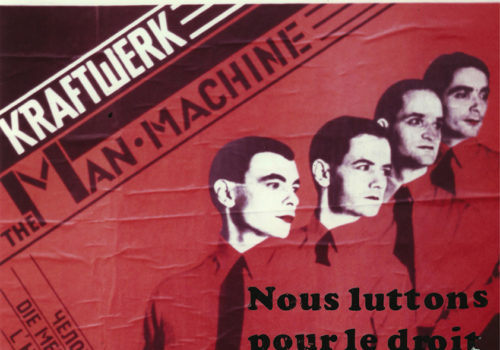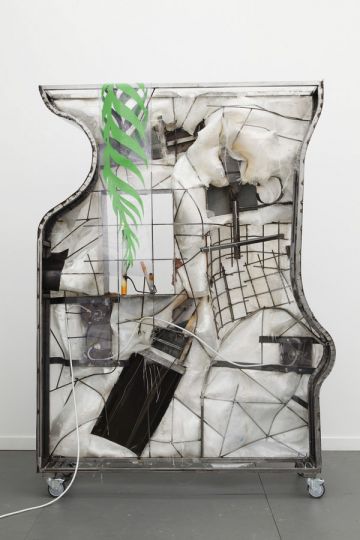Featuring emerging or newly discovered little-known visionary artistic scenes and taking risks with many solo shows, the second edition of OFFICIELLE upholds its vocation as a headhunter for FIAC. It focuses on practitioners who challenge the themes and modes of production and dissemination of images. It encompasses territories in motion and pluralistic visions that tackle the notions of landscape, memory, persistence and erasure, political engagement and activism, and the state of the world.
Julian Charrière (1987, Switzerland), Dittrich & Schlechtriem
Combining geology, science, and architecture, the French-Swiss artist Julian Charrière explores human interventions on the planet and our perception of images. Starting with J.G. Ballard’s early short story, “The Terminal Beach,” Charrière set out to photograph the nuclear test site of Semipalatinsk, in Kazakhstan—that “future fossil” which he captured on film using samples of radioactive sand. In this experimental work done in a wasteland and focused on the interference of man in the environment and on time cycles, Charrière offers a tangible trace of a moment in the history of human madness.
Adrian Melis (1985, Cuba), ADN Galeria
Inspired by his living conditions in Cuba before his exile in Europe, Adrian Melis questions the tensions between the different socioeconomic and political regimes and individual strategies of resistance. The video “The New Man and My Father” places his own father in the role of an archetype of a generation marked by the creed of revolution, speechless in the face of programmatic ideological disenchantment, and confused by the recent opening of the island onto the world. The series of photographs “Replacement points,” shot in Barcelona, deals with the erasure of old resistance slogans from the walls, now freshly repainted. Finally, the installation “Production plan of dreams for state-run companies in Cuba,” composed of boxes containing the dreams of workers dozing off at their posts and photographs documenting the project and its participants, questions the paradoxical notion of productivity in these state institutions and the secret complicity between the workers and the artist.
Marcos Avila Forero (1983), Dohyanglee
A graduate of the École Nationale Supérieure des Beaux-Arts in Paris (in 2010), Marcos Avila Forero draws on the violent socio-political reality of his home country of Colombia, by means of micro-narratives where wandering and the hors-champ become the medium for transmitting the wounds of the places encountered. The pinhole photographs of “Sténopés de paysages révoltés” are part of a larger project entitled “Restitution à la mémoire” conducted in Colombia in close cooperation with the local population. It represents a deliberate choice that embodies the modes of survival and secrecy among the activists of memory.
Aurélie Pétrel (1980, France), Houg galerie
In her “photographic scores,” Aurélie Pétrel continues the reflection on the medium as space of freedom following the thought of Marie-José Mondzain. Voiceless, latent images that she activates and transposes into the three dimensions in a skillful play of construction and projection, effacing the boundaries between the subject, its transfer, and its environment.
Aglaia Konrad (1960, Autria), Nadja Vilenne
During her world travels, Aglaia Konrad documents the expansion of urban agglomerations and the emergence of new cities in all their standardized banality. Collected in an archive which she draws on in countless formats and combinations, these vertiginous images, here viewed from above, destabilize the supposed stillness of photography.
Sanja Iveković (1949, Croatia), Espaivisor
The first woman in the Yugoslav/Croatian art scene to have a decidedly feminist discourse, Sanja Iveković analyzes identity building in the media with the strategy of an activist whereby the body mirrors socio-political realities of the former Yugoslavia in video, collage, film, and installation. The project GEN XX consists of a series of photographs published between 1997 and 1998 as magazine ads associating iconic models with heroines who have been forgotten by the collective memory. Depriving the advertisement of its message and logo, the artist infiltrates and dismantles the founding myth of the Yugoslavian Socialist Republic by breathing life into the individual destiny of young resisters executed by the regime and forgotten by the present generations of women. Iveković’s subversive work questions the links between sexualized genres, power, and feminine stereotypes disseminated through images.
Teresa Gierzynska (1947, Poland), Pola Magnetyczne
The cycle Traces (Traces of Victory, of Freedom, and of Friendship), completed in 1979, associates the personal memory of the artist, first trained as a sculptor, and the repressions in Poland of the 1970s. This photographic inventory of commemorative sculptures in the form of the most banal blue-tinted postcards is like persistence of vision in the face of ongoing ideological devastation. Gierzynska’s work resonates with that of other key figures in the Polish art scene at the time who, confronted with a reversal of values and loss of faith in modernist utopias, worked to make room for the artist as an engaged observer.
FAIR
Officielle
21-25 October 2015
Les Docks – Cité de la Mode et du Design
34 Quai d’Austerlitz
75013 Paris

















